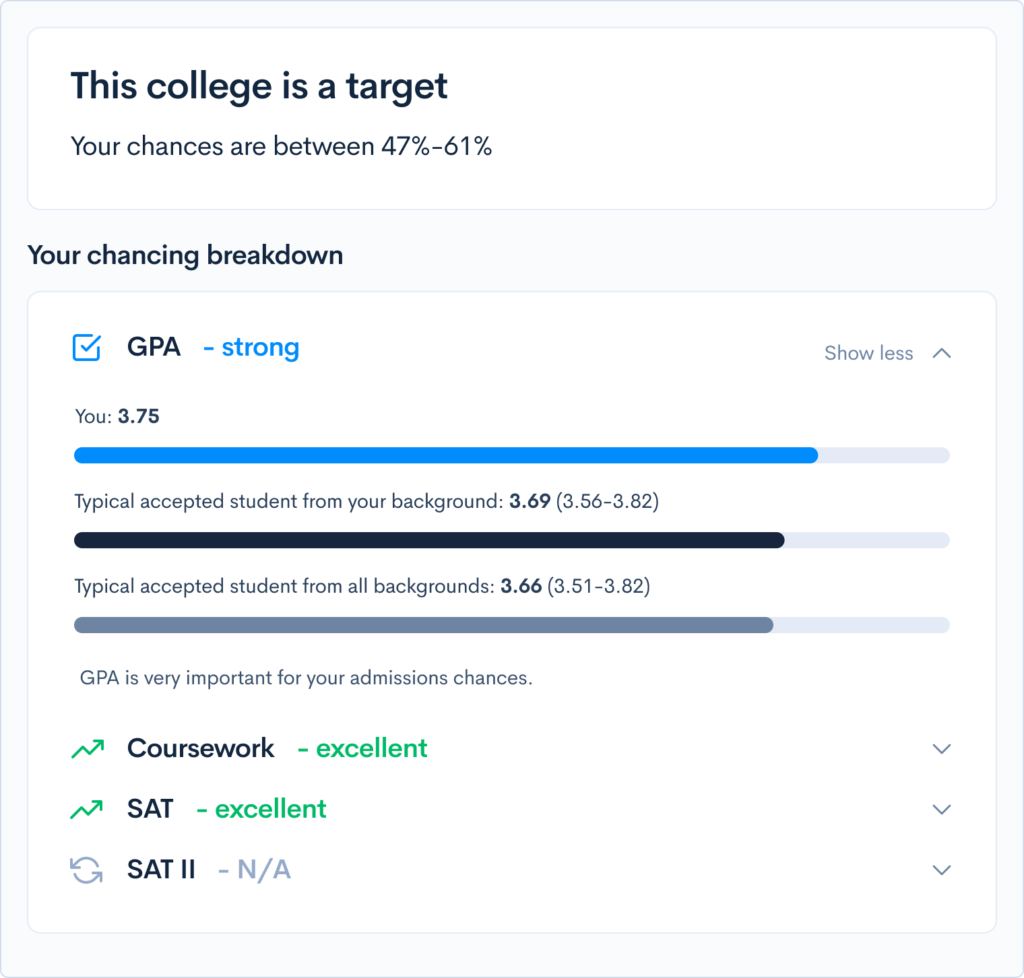What is Harvard Known For?
The oldest institution of higher learning in the United States, Harvard University is a household name. Students around the world dream of attending the extremely selective and prestigious university. Harvard is much more than just a symbol — it’s a university with exemplary academics, rich traditions, and a tight-knit community. Location: Cambridge, Massachusetts Undergrad Enrollment: 9,900 Acceptance Rate: 5% Middle 50% SAT: 710-770 (EBRW)/750-800 (M) Middle 50% ACT: 33-35 In addition to an outstanding academic record, Harvard values leadership and community engagement in applicants, preferring those who have made an impact on and are involved with their communities. Candidates should demonstrate these qualities through their activities section and supplemental essays. Harvard also values intellectualism, especially in the humanities and social sciences, and looks favorably upon students with interesting academic backgrounds who have engaged in their passions through research, fieldwork, or other extracurricular involvement. For more tips on your application, see our guide to getting into Harvard, written by a Harvard grad. Harvard boasts world-renowned faculty, including Nobel laureates, Pulitzer Prize-winning authors, and other leaders of their fields. Undergraduates have plenty of opportunities to engage with faculty even outside their classes, through First-Year Faculty Dinners, Faculty-Student Initiatives, the Faculty Luncheon Series, and more. Students learn important academic and career skills through Academic Life Workshops. In the past, they have included topics like Study Skills and Preparing for Midterm Exams, Résumé Writing 101 Workshop, Entering the World of Research, and Using Social Media in your Social Science Projects. The foundation of Harvard’s academic life is its deep commitment to liberal arts and sciences, which prepares students to think critically, reason analytically, and write clearly. All students take General Education courses, which encourage them to connect the topics they study with the world beyond the classroom. Students will grapple with difficult questions and urgent issues, including climate change, racism, artificial intelligence, and many others. Harvard offers more than 3,700 courses and 50 majors, called concentrations, across: Roughly half of students pursue an honors track within their concentration. Students may also create their own special concentration that addresses a “uniquely challenging academic goal” with approval. Students may also pursue a secondary field (equivalent to a minor). Learn more about Harvard majors and minors in our guide. Harvard students with advanced standing can apply to earn a master’s degree in certain disciplines in their fourth year. They can also cross-enroll or take courses at Harvard’s graduate schools and other institutions in Cambridge or Boston. Harvard also offers dual-degree music programs with the New England Conservatory and Berklee College of Music. Students who participate earn both an AB from Harvard and a master’s from one of these two renowned music schools. There are plenty of research opportunities available to undergraduates through the Harvard Research Program, the Mellon Mays Undergraduate Fellowship Program, the Faculty Aide Program, and other programs. More than half of Harvard College students study abroad as undergraduates. Students can choose from options like Cambridge or Oxford, as well as programs in Argentina, Cameroon, Chile, China, Cuba, Czech Republic, France, Greece, India, Israel, Italy, Lebanon, New Zealand, South Africa, Turkey, and many other countries. Harvard offers 42 Division I sports teams, the most of any college in the U.S. The Crimson also compete in the Ivy League. Varsity athletics include: The university also has club teams, such as: Over 80% of students participate in some type of athletics. Additionally, Harvard offers more than 450 student organizations. Whatever your interest — literature, music, religion, politics, writing, art, or multicultural organizations — the university has something to offer. The Harvard Lampoon, is one of the longest-running continually published humor magazines in the world. Other organizations of note include Act on a Dream, which encourages students to learn about and advocate for immigration reform, and Beekeepers, focusing, of course, on beekeeping. One of Harvard’s most time-honored traditions is an annual event known as “The Game.” Far more than a football game, this event celebrates the rivalry between the Crimson and the Yale Bulldogs. Harvard has a number of other celebrated events, though none as widely attended as The Game. They include: First-year students live in Harvard Yard, usually in suites, and have the opportunity to participate in activities to help them bond with fellow students. They are then assigned to one of Harvard’s 12 Houses, which are homes to 350-500 students with whom you’ll share meals, participate in activities, and develop connections. Houses are led by faculty deans who live in the facility with their families. Harvard is one of just five four-year colleges that practices need-blind admissions for all applicants, including international students. The university meets 100% of demonstrated need and is no-loan for accepted students. World-famous libraries housing treasures and artifacts like the Gutenberg Bible, cutting-edge research facilities, digital collections, and art and science museums are just some of the resources students can access at Harvard. Harvard also has Common Spaces, such as the Chairs at Harvard Yard, available in the spring, and the Plaza, which features events like the Arts First Festival, Farmer’s Market, a monthly petting zoo, chair massages, and lunchtime concerts. Students can also get discounted event tickets and entrance to nearby museums and attractions like the Museum of Fine Arts and the New England Aquarium. Just a 10-minute ride on the T will get you to Boston from Harvard, but you’ll find plenty to do without leaving Cambridge. The city is largely defined by Harvard and its neighbor, MIT, and offers plenty of museums, shops, and restaurants. Harvard Square, a plaza with bookstores, music, theaters, art, and restaurants, draws millions of visitors each year. Boston and Cambridge together have more than 50 institutions of higher learning, making the area a city with a collegiate-town vibe. Harvard is one of the most selective universities in the world. While you may be anxious about its extremely low acceptance rate, your unique chances of admission depend on factors like your GPA, standardized test scores, leadership and community engagement, intellectual pursuits, and more. You can learn more about your odds of acceptance to the highly acclaimed college by using our chancing engine. Based on your profile, we’ll estimate your real chances of admission to Harvard and other schools across the country. We’ll also give you free tips to improve your profile. What’s Covered:
Overview of Harvard Admissions
Unique Aspects of Harvard
Academics
Extracurriculars

Traditions
Dorms
Financial Aid
Families earning between $65,000 and $150,000 can expect to contribute 0-10% percent of their annual income. Twenty percent of Harvard families pay nothing for attendance.Resources
Location
What Are Your Chances of Acceptance at Harvard?



